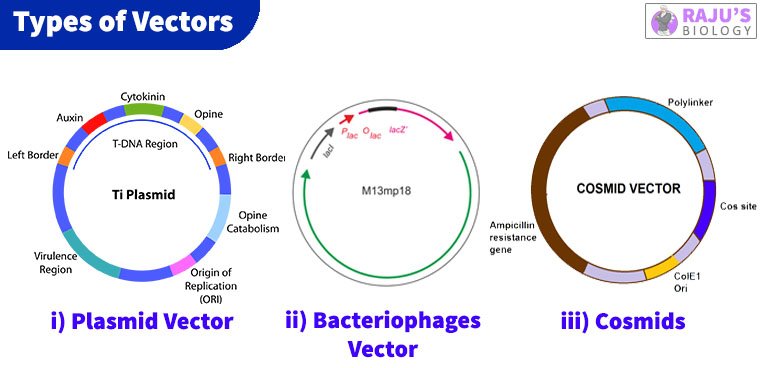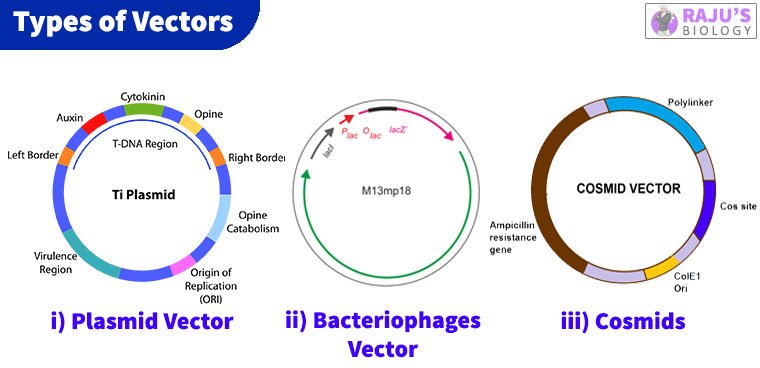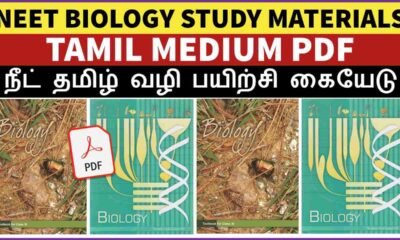Blog
Cloning Vector Definition, Features and Types

This article we will discuss about 1.What is a Cloning Vector? 2.General Characteristics of Cloning Vector 3.Features of Cloning Vectors and 4.Types of Cloning Vectors

1.What is a Cloning Vector?
A cloning vector is also a fragment of DNA which is capable of self-replication and stable maintenance inside the host organism. It can be extracted from a virus, plasmid or cells of a higher organism. Most of the cloning vectors are genetically engineered. It is selected based upon the size and the kind of DNA segment to be cloned.
2.General Characteristics of Cloning Vector
- It should small in size.
- It must have an origin of replication.
- It must also be compatible with the host organism.
- It must possess a restriction site.
- The introduction of donor fragment must not intervene with the self-replicating property of the cloning vector.
- A selectable marker, possibly an antibiotic resistance gene, must be present to screen the recombinant cells.
- It should be capable of working under the prokaryotic as well as the eukaryotic system.
- Multiple cloning sites should be present.
3.Features of Cloning Vectors
1. Origin of Replication (ori)
- A specific set/ sequence of nucleotides where replication initiates.
- For autonomous replication inside the host cell.
- Foreign DNA attached to ori also begins to replicate.
2. Cloning Site
- Point of entry or analysis for genetic engineering.
- Vector DNA at this site is digested and foreign DNA is inserted with the aid of restriction enzymes.
- Recent works have discovered plasmids with multiple cloning sites (MCS) which harbour up to 20 restriction sites.
3. Selectable Marker
- Gene that confers resistance to particular antibiotics or selective agent which, under normal conditions, is fatal for the host organism.
- Confers the host cell the property to survive and propagate in culture medium containing the particular antibiotics.
4. Marker or Reporter Gene
- Permits the screening of successful clones or recombinant cells.
- Utilized extensively in blue-white selection.
5. Inability to Transfer via Conjugation
Vectors must not enable recombinant DNA to escape to the natural population of bacterial cells.
4.Types of Cloning Vectors
- Plasmids
- Bacteriophage
- Phagemids
- Cosmids
- Bacterial Artificial Chromosome (BAC)
- Yeast Artificial Chromosome (YAC)
- Human Artificial Chromosome (HAC)
- Retroviral Vectors
I) Plasmids:
- Plasmids were the first vectors to be used in gene cloning.
- They are naturally occurring and autonomously replicating extra-chromosomal double-stranded circular DNA molecules. However, not all plasmids are circular in origin.
- They are present in bacteria, archaea, and eukaryotes.
- The size of plasmids ranges from 1.0 kb to 250 kb.
- DNA insert of up to 10 kb can be cloned in the plasmids.
- The plasmids have high copy number which is useful for production of greater yield of recombinant plasmid for subsequent experiments.
- The low copy number plasmids are exploited under certain conditions like the cloned gene produces the protein which is toxic to the cells.
- Plasmids only encode those proteins which are essential for their own replication. These protein-encoding genes are located near the ori.
- Examples: pBR322, pUC18, F plasmid, Col plasmid.
Advantages of using Plasmids as vectors:
- Easy to manipulate and isolate because of small size.
- More stable because of circular configuration.
- Replicate independent of the host.
- High copy number.
- Detection easy because of antibiotic-resistant genes.
Disadvantages of using Plasmids as vectors:
- Large fragments cannot be cloned.
- Size range is only 0 to 10kb.
- Standard methods of transformation are inefficient.
II. Bacteriophage
- Bacteriophages or phages are viruses which infect bacterial cells.
- The most common bacteriophages utilized in gene cloning are Phage λ and M13 Phage.
- A maximum of 53 kb DNA can be packaged into the phage.
- If the vector DNA is too small, it cannot be packaged properly into the phage.
- Examples: Phage Lambda, M13 Phage, etc.
Types of Phage Vectors
There are 2 types of phage vectors:
- Insertion vectors – these contain a particular cleavage site where the foreign DNA of up to 5-11 kb can be inserted.
- Replacement vectors – the cleavage sites flank a region which contains genes not necessarily important for the host, and these genes can be deleted and replaced by the DNA insert.
Advantages of using Phage Vectors
- They are way more efficient than plasmids for cloning large inserts.
- Screening of phage plaques is much easier than identification of recombinant bacterial colonies.
III. Phagemids or Phasmid
- They are prepared artificially.
- Phasmid contains the F1 origin of replication from F1 phage.
- They are generally used as a cloning vector in combination with M13 phage.
- It replicates as a plasmid and gets packaged in the form of single-stranded DNA in viral particles.
Advantages of using Phagemids:
- They contain multiple cloning sites.
- An inducible lac gene promoter is present.
- Blue-white colony selection is observed.
IV. Cosmids
- Cosmids are plasmids.
- They are capable of incorporating the bacteriophage λ DNA segment. This DNA segment contains cohesive terminal sites (cos sites).
- Cos sites are necessary for efficient packaging of DNA into λ phage particles.
- Large DNA fragments of size varying from 25 to 45 kb can be cloned.
- They are also packaged into λ This permits the foreign DNA fragment or genes to be introduced into the host organism by the mechanism of transduction.
Advantages of using cosmids as vectors:
- They have high transformation efficiency and are capable of producing a large number of clones from a small quantity of DNA.
- Also, they can carry up to 45 kb of insert compared to 25 kb carried by plasmids and λ.
Disadvantages of using cosmids as vectors:
- Cosmids cannot accept more than 50 kb of the insert.
V) Bacterial Artificial Chromosomes (BACs)
- Bacterial artificial chromosomes are similar to E. coli plasmid vectors.
- They contain ori and genes which encode ori binding proteins. These proteins are critical for BAC replication.
- It is derived from naturally occurring F’ plasmid.
- The DNA insert size varies between 150 to 350 kb.
Advantages of BACs:
- They are capable of accommodating large sequences without any risk of rearrangement.
- BACs are frequently used for studies of genetic or infectious disorders.
- High yield of DNA clones is obtained.
Disadvantages of BACs:
- They are present in low copy number.
- The eukaryotic DNA inserts with repetitive sequences are structurally unstable in BACs often resulting in deletion or rearrangement.
VI) Yeast Artificial Chromosomes (YACs)
- A large DNA insert of up to 200 kb can be cloned.
- They are used for cloning inside eukaryotic cells. These act as eukaryotic chromosomes inside the host eukaryotic cell.
- It possesses the yeast telomere at each end.
- A yeast centromere sequence (CEN) is present which allows proper segregation during meiosis.
- The ori is bacterial in origin.
- Both yeast and bacterial cells can be used as hosts.
Advantages of using YACs:
- A large amount of DNA can be cloned.
- Physical maps of large genomes like the human genome can be constructed.
Disadvantages of using YACs:
- Overall transformation efficiency is low.
- The yield of cloned DNA is also low.
VII) Human Artificial Chromosome (HACs)
- Human artificial chromosomes are artificially synthesized.
- They are utilized for gene transfer or gene delivery into human cells.
- It can carry large amounts of DNA inserts.
- They are used extensively in expression studies and determining the function of the human chromosomes.
Advantages of using HACs:
- No upper limit on DNA that can be cloned.
- it avoids the possibility of insertional mutagenesis.
- Human Artificial Chromosome
VIII. Retroviral Vectors
- Retroviruses are the virus with RNA as the genetic material.
- Retroviral vectors are used for introduction of novel or manipulated genes into the animal or human cells.
- The viral RNA is converted into DNA with the help of reverse transcriptase and henceforth, efficiently integrated into the host cell.
- Any gene of interest can be introduced into the retroviral genome. This gene of interest can then integrate into host cell chromosome and reside there.
Advantages of using retroviral vectors:
- They are widely used as a tool to study and analyze oncogenes and other human genes.

 Entertainment2 months ago
Entertainment2 months agoIbomma Bappam: Redefines Telugu Streaming Trend

 Blog2 months ago
Blog2 months ago[PPT] The living world Class 11 Notes
- Blog2 months ago
PG TRB Botany Study Material PDF Free Download

 Blog1 month ago
Blog1 month agoIosmirror.cc Apk: Enables Smart Screen Sharing
- Blog2 months ago
Class 12 Biology Notes Chapter wise PPT

 Blog2 months ago
Blog2 months ago[PPT] Human Reproduction Class 12 Notes
- Blog2 months ago
Class 11 Biology Notes Chapter wise PPT

 Blog2 months ago
Blog2 months agoDownload NEET Biology Study Materials in Tamil











